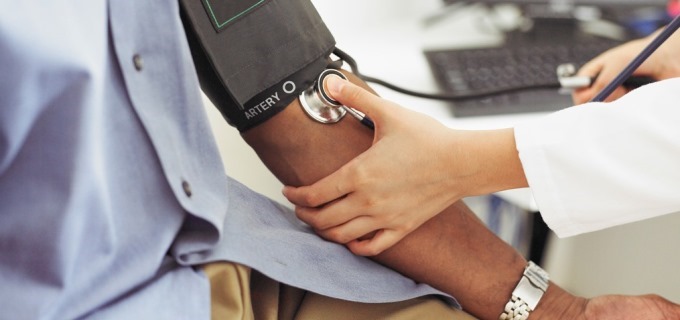Search for a doctor or hospital in your network.


Search for a doctor or hospital in your network.

Get News & Updates Directly To Your Inbox

Nearly half of adults in the U.S., about 116 million people, have high blood pressure, says the Centers for Disease Control and Prevention. ![]() And only 25 percent of them have it under control.
And only 25 percent of them have it under control.
High blood pressure (HBP) can be deadly. And many people don’t know they have it. That’s why it’s called "the silent killer." The only way to know if you’re at risk is to have it checked often.
Blood pressure is the force of blood against your artery walls as it circulates through your body. Blood pressure often rises and falls throughout the day, but it can cause health problems if it stays high.
Anyone, including children, can have it. Some things that are beyond your control can raise your risk for high blood pressure. These include your age, sex, and race or ethnicity. But you can lower your risk with lifestyle changes. ![]() That includes keeping a healthy weight, being physically active, not smoking and eating a healthy diet. Talk with your doctor about what you can do to lower your risk for high blood pressure.
That includes keeping a healthy weight, being physically active, not smoking and eating a healthy diet. Talk with your doctor about what you can do to lower your risk for high blood pressure.
High blood pressure usually has no warning signs or symptoms, so many people don’t realize they have it. That’s why it’s vital to have your blood pressure checked regularly. ![]()
Checking your blood pressure is the only way to find out if you have high blood pressure.
Blood pressure readings measure two things. One is the force that pushes on the walls of your blood vessels as they carry blood and oxygen to your organs. That is called systolic pressure.
The second number is the pressure in your blood vessels when your heart rests between beats. That is called diastolic pressure.
If either number is too high, it means that your blood vessels are under too much pressure. That can raise your risk for blood clots and other serious health problems.
One method of checking is at your doctor’s office. Most often, they’ll check it by wrapping an inflatable cuff with a pressure gauge around your arm to squeeze the blood vessels. Then they listen to your pulse with a stethoscope while releasing air from the cuff.
The gauge measures the pressure in the blood vessels when the heart beats (systolic) and when it rests (diastolic).
Another method is checking your blood pressure at home. Home blood pressure monitors are cheap to buy, often starting at $20. And they’re easy to use. Many store your readings so you can show them to your doctor. It’s a good way to track an important measure of your health.
Home blood pressure monitoring can lead to moderate decreases in blood pressure. But many people don’t do it. In a recent study ![]() of adults 50 to 80 years old, less than half of those with high blood pressure (hypertension) regularly checked their blood pressure.
of adults 50 to 80 years old, less than half of those with high blood pressure (hypertension) regularly checked their blood pressure.
Like any other healthy habit, monitoring your blood pressure at home only helps if you do it. Try linking it to something you remember to do regularly. Or aim for the same time each day. Soon you won’t even have to remind yourself.
Whether you get your blood pressure measured at your doctor’s office or do it yourself at home, it’s important to make sure it’s being measured correctly.
If you have high blood pressure, your doctor may prescribe medicine to treat it. And lifestyle changes can be just as important as taking medicines.
Try these tips for lowering your blood pressure from the American Heart Association:
If you have high blood pressure, be sure to check it regularly and take any medicine your doctor orders as directed. If you have any side effects, don’t stop taking it without checking with your doctor first.
Blue Cross and Blue Shield of Oklahoma, a Division of Health Care Service Corporation,
a Mutual Legal Reserve Company, an Independent Licensee of the Blue Cross and Blue Shield Association
© Copyright 2026 Health Care Service Corporation. All Rights Reserved.
Verint is an operating division of Verint Americas, Inc., an independent company that provides and hosts an online community platform for blogging and access to social media for Blue Cross and Blue Shield of Oklahoma.
![]() File is in portable document format (PDF). To view this file, you may need to install a PDF reader program. Most PDF readers are a free download. One option is Adobe® Reader® which has a built-in screen reader. Other Adobe accessibility tools and information can be downloaded at https://www.adobe.com/trust/accessibility.html.
File is in portable document format (PDF). To view this file, you may need to install a PDF reader program. Most PDF readers are a free download. One option is Adobe® Reader® which has a built-in screen reader. Other Adobe accessibility tools and information can be downloaded at https://www.adobe.com/trust/accessibility.html. ![]()
![]() You are leaving this website/app ("site"). This new site may be offered by a vendor or an independent third party. The site may also contain non-Medicare related information. Some sites may require you to agree to their terms of use and privacy policy.
You are leaving this website/app ("site"). This new site may be offered by a vendor or an independent third party. The site may also contain non-Medicare related information. Some sites may require you to agree to their terms of use and privacy policy.
Powered by Verint